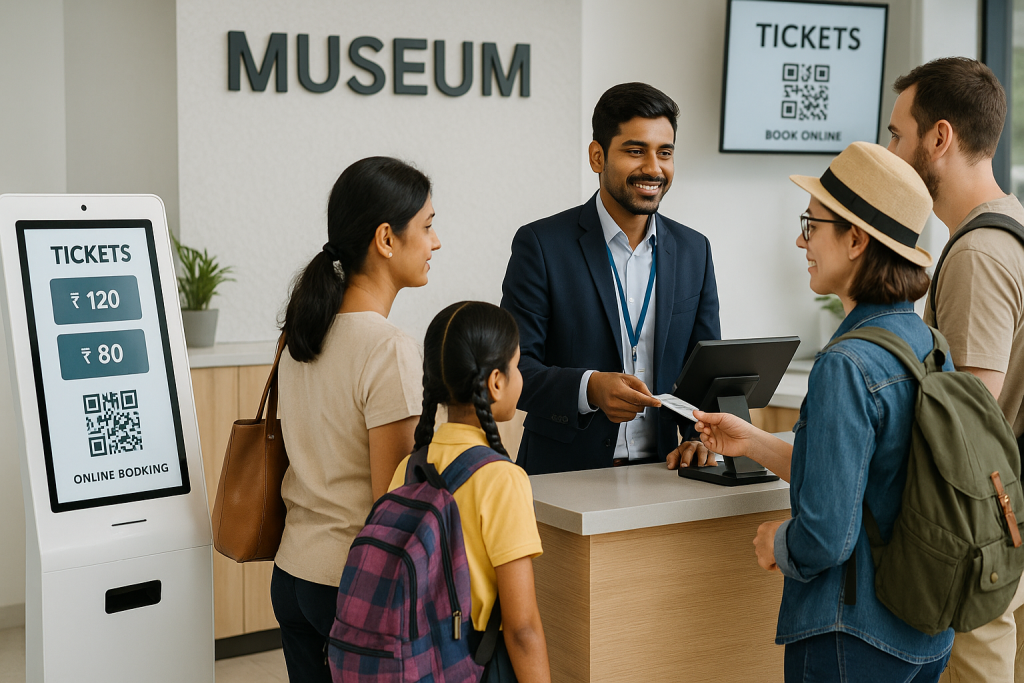Can artificial intelligence make museum visits more engaging, personalized, and efficient? Across the globe and increasingly in India, museums are turning to AI to reimagine how culture and technology intersect.
In this blog, we’ll explore how artificial intelligence is reshaping modern museum experiences by offering deep visitor insights, optimizing operations, and fueling growth across India’s cultural institutions.
Whether you’re a museum curator, cultural leader, or tech innovator, this guide highlights how AI is becoming an essential tool in the digital transformation of museums.
Let’s dive into how India’s heritage spaces are getting smarter, more connected, and future-ready with AI by EveryTicket.
Understanding Artificial Intelligence in the Museum Context
Artificial intelligence in museums isn’t just about robots or futuristic tech, it’s about creating smarter, more responsive cultural experiences. For museums, AI represents a shift from static exhibits to dynamic, data-driven engagement.
What AI Means for Cultural Institutions
At its core, AI enables museums to interpret large volumes of visitor data and translate it into actionable insights. This includes tracking visitor behavior, predicting exhibit popularity, and customizing experiences based on user preferences. For cultural institutions, especially those with diverse audiences, this allows for more personalized and inclusive storytelling.
Types of AI Technologies Used in Museums
Several forms of AI are now actively used in museum environments:
- Computer vision: Recognizes visitor movements or facial expressions to measure engagement.
- Natural language processing (NLP): Powers AI chatbots that assist with FAQs or provide interactive exhibit tours.
- Recommendation engines: Tailor content suggestions based on visitor preferences or past behavior.
- Predictive analytics: Helps forecast footfall trends, aiding in staff planning and exhibit rotation.
These technologies are transforming how museums operate, creating not only more immersive experiences for visitors but also enabling smarter internal decision-making.
Why AI Matters for Indian Museums
India’s museums hold some of the world’s richest cultural and historical artifacts, yet many institutions face mounting challenges in attracting, engaging, and retaining modern audiences. Here’s where AI enters the picture.
Challenges Faced by Indian Museums Today
Many Indian museums grapple with limited funding, outdated infrastructure, and a lack of digital tools to meet evolving visitor expectations. Traditional methods of exhibit curation and visitor management often fall short in delivering engaging experiences, especially to younger, tech-savvy audiences.
Additionally, inconsistent data collection makes it difficult for museums to understand visitor preferences, track performance metrics, or evaluate the success of exhibitions.
The Urgency for Digital Transformation
Artificial intelligence in museums offers Indian cultural institutions a timely opportunity to leap forward.
By adopting AI-powered museum management tools and analytics platforms, museums can:
- Streamline operations
- Gain deeper visitor insights
- Enhance overall engagement
- Develop data-driven growth strategies
Whether it’s through AI analytics for museums or museum visitor analytics, the goal is to make every museum visit more impactful while ensuring institutions remain relevant in an increasingly digital world.
Digital transformation isn’t a trend, it’s a necessary evolution for India’s museums to preserve heritage, connect with new generations, and build sustainable models for the future.
Applications of AI in Museums
Artificial intelligence in museums is redefining how institutions understand their audiences, operate internally, and create engaging exhibits. These applications aren’t abstract, they’re already helping museums in India and around the world become more visitor-focused and future-ready.
Visitor Analytics and Personalization
Museums have long struggled to understand what truly resonates with their visitors. Traditional feedback forms or manual headcounts offer limited insight. That’s where AI analytics for museums comes into play.
- Tracking Behavior and Engagement
Using sensors and computer vision, museums can now track visitor movements, time spent at each exhibit, and areas of high or low engagement. This real-time museum visitor data helps institutions identify which displays capture the most attention and why.
- Delivering Tailored Visitor Experiences
With these insights, museums can begin personalizing experiences. Think dynamic signage that changes based on crowd flow, or AI-powered apps that recommend exhibits based on visitor interests or time constraints. It’s a significant step toward enhancing museum experiences with AI, making each visit feel more curated and memorable.
Operational Efficiency
Behind every great exhibit is a complex web of operations from staffing and maintenance to ticketing and crowd control. AI streamlines these tasks, allowing museums to focus on delivering high-quality experiences.
- Streamlining Staff Planning, Ticketing, and Resource Use
AI can predict peak visiting hours and adjust staff scheduling accordingly. Automated ticketing systems and predictive maintenance tools reduce manual workloads while improving efficiency.
- Predictive Planning for Peak Times and Special Events
Using historical data and predictive models, museums can forecast visitor spikes for holidays or special exhibitions. This level of foresight is key for optimizing museum operations with AI, ensuring smoother crowd flow and better visitor satisfaction.
Enhancing Exhibits and Engagement
Modern visitors expect more than static displays; they want to interact, explore, and immerse themselves in stories. AI empowers museums to meet these expectations through cutting-edge technologies.
- Interactive Guides, AR/VR Experiences
AI chatbots can serve as multilingual guides, answering questions or providing context in real-time. When paired with AR/VR, museums can transform how history is experienced, from walking through ancient ruins to engaging with virtual reconstructions of lost artifacts.
- Adaptive Content for Diverse Audiences
Using AI tools for cultural institutions, museums can tailor content based on visitor profiles, age groups, or even learning styles. This ensures the exhibits are accessible and meaningful to everyone, from schoolchildren to scholars.
Case Examples and Implementations
The adoption of artificial intelligence in museums is no longer theoretical. Several Indian institutions have begun exploring and applying AI technologies to address real challenges, boost engagement, and modernize their cultural offerings.
Real-World AI Initiatives: MAP Bangalore and EveryTicket
One notable implementation comes from the Museum of Art & Photography (MAP), Bangalore, in partnership with EveryTicket, a smart ticketing and visitor engagement platform.
MAP leveraged AI-powered museum management through EveryTicket to:
- Track and analyze visitor behavior in real-time, including entry trends, exhibit interactions, and repeat visits.
- Enable data-driven decisions for scheduling, staffing, and exhibition planning.
- Offer personalized visitor experiences based on preferences, interests, and past behavior.
- Optimize ticketing operations using predictive analytics for museums, ensuring smoother crowd management during peak hours and special events.
This initiative highlights how AI solutions for Indian museums can create seamless, engaging, and scalable systems that benefit both cultural institutions and their audiences.
How AI Is Already Reshaping Cultural Spaces
Beyond operational efficiencies, AI is helping museums reimagine their roles as living cultural spaces.
Through AI-powered museum management, institutions can now:
- Adapt exhibits based on real-time visitor behavior
- Provide personalized educational experiences
- Forecast trends using museum data analysis in India
- Develop new revenue models through smart ticketing and targeted memberships
These use cases showcase how AI applications in museums are not just supporting, but actively reshaping how cultural heritage is curated and consumed.
Future of AI in Museums
The next wave of AI in museums promises even deeper transformation—not just in tools and technologies, but in how we define engagement, accessibility, and cultural relevance.
Emerging Trends and Innovations
Several exciting trends are already on the horizon:
- Generative AI may allow museums to recreate lost artifacts or simulate historical environments based on existing data.
- Emotion recognition systems could tailor content in real-time, offering different narrative tones based on visitor reactions.
- AI-driven curatorial assistants may help design exhibits by analyzing data on past performance, visitor demographics, and current cultural trends.
These innovations align with larger museum industry trends, AI is enabling focusing on agility, adaptability, and deeper audience connection.
Potential for Broader Cultural Transformation
The long-term impact of AI goes beyond just digitizing collections or predicting visitor traffic. It touches on how museums contribute to society—making culture more participatory, more inclusive, and more dynamic.
By embracing AI data tools for museums, India’s institutions have a unique opportunity to:
- Democratize access to cultural knowledge
- Reach remote or underrepresented audiences
- Position themselves as forward-thinking centers for education and innovation
The fusion of artificial intelligence in museums and India’s rich cultural heritage could become a powerful global example of how tradition and technology can evolve together.
Challenges in Adopting AI
While the promise of artificial intelligence in museums is compelling, the journey toward full adoption isn’t without hurdles, especially for many Indian cultural institutions operating with limited budgets and legacy infrastructure.
Cost, Technical Skills, and Data Privacy
Implementing AI analytics for museums often requires substantial initial investment in software, hardware, and skilled personnel. For smaller museums or government-run institutions, these costs can be prohibitive. Additionally, maintaining and analyzing museum visitor data demands ongoing technical expertise, something that many museums currently lack.
Another critical concern is data privacy. As institutions gather more personal and behavioral data, ensuring compliance with privacy laws and ethical guidelines becomes essential. Museums must tread carefully, using AI data tools in ways that are transparent and responsible.
Balancing Innovation with Cultural Sensitivity
AI offers incredible potential, but cultural spaces must remain mindful of their responsibility to preserve authenticity and historical integrity. Not every exhibit needs gamification or virtual overlays. Striking the right balance between modern technology and traditional storytelling is vital.
Indian museums must evaluate where AI solutions enhance meaning and where they might distract from it. Success lies in using AI to empower curators, not replace them, and in making museum data-driven decisions that uphold cultural values.
Conclusion
From smart visitor guides to predictive analytics and immersive experiences, artificial intelligence in museums is driving a new era of growth, engagement, and operational efficiency. Across India, cultural institutions are beginning to unlock the power of data to understand their audiences better, optimize resources, and adapt to changing visitor expectations.
Despite the challenges, the digital transformation for museums is no longer a distant future—it’s happening now. As more museums embrace AI tools for cultural institutions, they’ll not only become more efficient and engaging but also more inclusive and relevant to today’s diverse audiences.
The road ahead calls for collaboration between technologists, curators, and policymakers. But one thing is clear: AI isn’t replacing culture, it’s enriching how we share, preserve, and experience it. For Indian museums, that means a smarter, more connected, and more sustainable future is within reach. Get in touch with us now to make our museum smarter.



